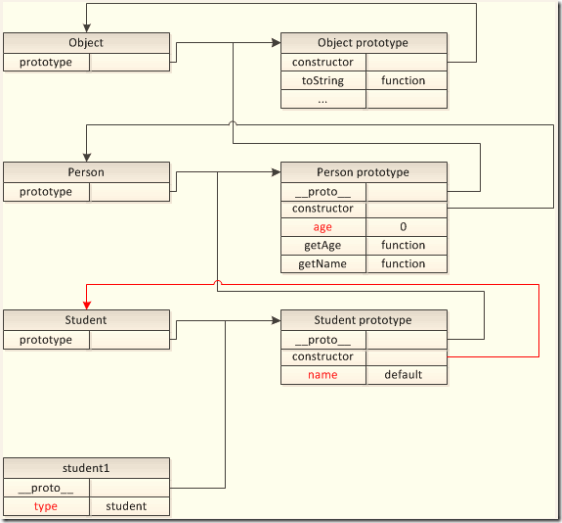由于javascript没有类的概念,因此无法通过接口继承,只能通过实现继承。实现继承是继承实际的方法,javascript中主要是依靠原型链要实现。
原型链继承
原型链继承是基本的继承模式,其本质是重写原型对象,使其为新对象的实例。代码实现如下:
function Person(){ this.name = "default"; var temp = "temp"; } Person.prototype.age=0; Person.prototype.getName = function(){ return this.name; } Person.prototype.getAge = function(){ return this.age; } console.log(Person.prototype.age);//0 console.log(Person.age);//undefined console.log(Person.prototype.name);//undefined console.log(Person.name);//Person, if other property, should be undefined function Student(){ this.type = "student"; } //inheritance Student.prototype = new Person(); console.log(Student.prototype.constructor);//Person(){} console.log(Student.prototype.name);//default Student.prototype.constructor = Student; var student1 = new Student(); console.log(student1.getName());//default console.log(student1.name);//default console.log(student1.getAge());//0 console.log(student1.age);//0 console.log(student1.__proto__.age);//0 console.log(student1.temp);//undefined console.log(student1 instanceof Object);//true console.log(student1 instanceof Person);//true console.log(student1 instanceof Student);//true console.log(Student instanceof Person);//false
以上代码主要注意两个问题:
1.函数局部变量,内部属性及原型属性的区别。var temp定义了一个局部变量,this.name定义了一个内部属性,prototype.age则定义了一个原型属性。
对于局部变量,无法在函数以外的地方调用,包括实例。
之前说过,函数本身的prototype属性仅仅用于函数实例的属性继承,而函数本身不会使用这个关联的prototype,在prototype中设置的属性将直接作用于所有实例。(比如Person的实例Student.prototype和student1,注意Student并不是Person的实例)
而对于函数内部属性,函数实例将直接拥有对应的内部属性(初始值),而无法通过函数本身使用内部属性。这一点其实跟prototype属性有所区别。
2.利用重写原型对象实现继承的时候,Student.prototype = new Person(), Student.prototype将指向了另一个对象Person.prototype,因此此时Student.prototype.constructor将指向Person函数。通过Student.prototype.constructor = Student 可以将其constructor重新指向Student。
通过原型链可以更好的理解上面的代码:
原型链继承的缺点
关于原型链继承的问题,其实就是跟通过原型方式创建对象的问题一样,就是原型中包含引用类型所带来的共享问题。
还有就是创建实例的时候,无法向构造器中传递参数。
构造函数继承
另一种经典的继承便是通过构造函数实现继承,即通过apply()和call()方法在子类构造函数内部调用父类构造函数。具体实现如下:
function Person(name){ this.name = name; this.friends = new Array(); } Person.prototype.age = 0; function Student(name){ Person.call(this, name); } var student1 = new Student("Huge"); student1.friends.push("Alan"); console.log(student1.name);//Huge console.log(student1.age);//undefined console.log(student1.friends);//["Alan"] var student2 = new Student("Heri"); student2.friends.push("Amly"); console.log(student2.name);//Heri console.log(student2.friends);//["Amly"] console.log(student1 instanceof Person);//false console.log(student1 instanceof Student);//true
通过构造函数继承的问题除了构造函数模式本身存在的缺点之外(重复实例化方法),也无法类型识别,因此在父类原型中定义的方法和属性无法在子类中调用。
组合继承
由于通过原型链继承和构造函数继承都有其优缺点,因此将这两种继承方式组合起来,使用原型链继承实现原型中方法和属性的继承,通过构造函数继承实现参数传递和引用类型继承,是javascript中最常用的继承模式。代码实现如下:
function Person(name, age){ this.name = name; this.age = age; this.friends = new Array(); } Person.prototype.getName = function(){ return this.name; } function Student(name, age){ this.type = "student"; Person.call(this, name, age); } Student.prototype = new Person(); Student.prototype.constructor = Student; var student1 = new Student("Huge", 15); student1.friends.push("Alan"); console.log(student1.name);//Huge console.log(student1.age);//15 console.log(student1.friends);//["Alan"] console.log(student1.getName());//Huge console.log(student1 instanceof Person);//true console.log(student1 instanceof Student);//true var student2 = new Student("Heri", 16); student2.friends.push("Amly"); console.log(student2.name);//Heri console.log(student2.age);//16 console.log(student2.friends);//["Amly"] console.log(Student.prototype.name);//undefined console.log(Student.prototype.friends);//[]
从代码可以看出,组合继承会调用两次父类的构造函数:创建子类原型的时候和在子类构造函数内部调用。实际上,第一次创建子类原型的时候,子类已经包含了父类对象的全部实例属性,因此当通过调用子类构造函数创建实例的时候,将会重写这些属性。即同时存在两组属性,一组在实例上,一组在子类原型中,如上代码中Student.prototype.friends返回的空数组。这就是调用两次父类构造函数的结果。
其他继承方式
Crockford曾经提出了prototypal inheritance以及与之结合的parasitic inheritance。通过原型创建基于原有对象的新对象,并为新对象增加功能。
//prototypal inhertance function createObject(obj){ function F(){} F.prototype = obj; return new F(); } //parasitic inheritance function enhanceObject(obj){ var enhanceObj = createObject(obj); enhanceObj.getName = function(){ return this.name; } return enhanceObj; } var person = { name : "Alan" }; var person1 = enhanceObject(person); console.log(person1.getName());//Alan
更进一步,为了避免组合继承模式两次调用父类构造函数的问题,可以利用parasitic inheritance来继承父类的原型,再将其指定给子类的原型。如下代码:
//prototypal inhertance function createObject(obj){ function F(){} F.prototype = obj; return new F(); } //parasitic inheritance function inheritPrototype(superObj, subObj){ var obj = createObject(superObj.prototype); obj.constructor = subObj; subObj.prototype = obj; } function Person(name, age){ this.name = name; this.age = age; this.friends = new Array(); } Person.prototype.getName = function(){ return this.name; } function Student(name, age){ this.type = "student"; Person.call(this, name, age); } inheritPrototype(Person, Student); var student1 = new Student("Huge", 15); student1.friends.push("Alan"); console.log(student1.name);//Huge console.log(student1.age);//15 console.log(student1.friends);//["Alan"] console.log(student1.getName());//Huge console.log(student1 instanceof Person);//true console.log(student1 instanceof Student);//true var student2 = new Student("Heri", 16); student2.friends.push("Amly"); console.log(student2.name);//Heri console.log(student2.age);//16 console.log(student2.friends);//["Amly"] console.log(Student.prototype.name);//undefined console.log(Student.prototype.friends);//undefined
可以看出,子类只调用了父类一次构造函数,避免在子类原型中创建不必要的属性。同时,原型链也保持不便,可以说是实现类型继承的最有效方式。
